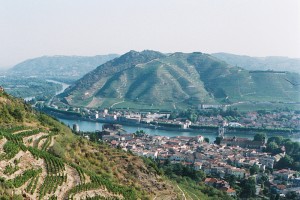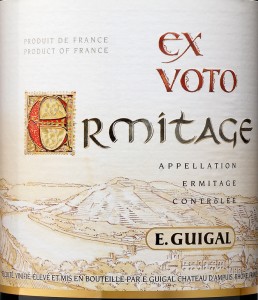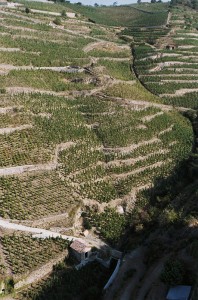Guigal Ex Voto, Hermitage.

Hill of Hermitage
A version of this article appeared in the Sept/Oct 2014 issue of Winestate magazine.
Guigal is one of the iconic names of the Rhône valley in France, despite being founded only in 1946. The company name retains the E of its founder, Etienne, succeeded in turn by Marcel, and now, just the third generation, Philippe, who is both winemaker and general manager.
As well as being an important negociant in the Rhône valley, buying fruit and blending wines from across the region, the family own more than 60 hectares amongst the most prestigious appellations of the northern Rhône including Côte Rôtie, Hermitage and Condrieu.
Hermitage is a tiny appellation of just 136 hectares on the slopes of the hill of Hermitage. Thirty producers work this land, and Guigal own two hectares of them. This is the hill that houses the tiny chapel – La Chapelle – of St Christopher, built on the site of a 12th century chapel.
The hill of Hermitage is the final, easterly outpost of the granitic Massif Central. It is the point at which the river Rhône turns sharply eastwards, before turning south again. This means the vineyards of Hermitage are all broadly south-facing – straight into the prized warmth of the sun – syrah grown here in the northern Rhône is at its coolest, northern (in the northern hemisphere) extreme of ripening.
 The label shows this wine as “Ermitage Ex Voto”. It’s still the Hermitage appellation. Producers are able to choose whether to use the ‘H’. Philippe Guigal explained “there is no rule regarding the use of an “H” or not in Hermitage but it is generally admitted that if the producer vinifies two Hermitages, his normal cuvée will come with the H (the classical way) and his tête de cuvée [top wine of that appellation] will come without the H (the historical way) but once again there is no real rule about it.”
The label shows this wine as “Ermitage Ex Voto”. It’s still the Hermitage appellation. Producers are able to choose whether to use the ‘H’. Philippe Guigal explained “there is no rule regarding the use of an “H” or not in Hermitage but it is generally admitted that if the producer vinifies two Hermitages, his normal cuvée will come with the H (the classical way) and his tête de cuvée [top wine of that appellation] will come without the H (the historical way) but once again there is no real rule about it.”
One of the things that makes Hermitage special are the parcels, or ‘climats’ with their significantly different soils, into which the hill is divided. Generally, there is granite in the west part with micaschist and gneiss; alluvial terraces and glacial deposits and loess in the east.
The names of these parcels are to be conjured with, including L’Hermite, where the famed La Chapelle is situated, and adjacent Les Bessards. Greffieux is at the bottom of the south-facing slope (separated from L’Hermite by another famous parcel, Le Méal), with Les Murets round to the east, a little. Ex Voto, made solely from syrah, comes from these parcels.

Les Bessards
The granite soils of Les Bessards make up 30% of the blend. Such granite-derived fruit typically forms the backbone of an Hermitage blend. Another 30% comes from the brown limestome-derived soils of Greffieux, with 20% each coming from L’Hermite which can bring freshness and fragrance to syrah fruit and Les Murets, a patch of Alpine glacial river origin stones and clay. Philippe summed up their contribution to the wine, saying “Les Bessards because of the granite produces a big, structured and framed wine; l’Hermite is more flexible, working for both white and red grapes and the reds always show good minerals; Les Greffieux with small pebbles produces rich and concentrated wines whereas les Murets brings an interesting finesse and delicacy to the blend.”
In addition, the Guigal parcels have a high proportion of old vines, some up to 90 years. Philippe said “I believe that old vines have the unique capacity to produce wines with a lot of dry extract. The power and the body of the Ermitage Ex-Voto is linked to its nature and its age.” In terms of bottle ageing capacity, 30 to 40 years is cited.
The name Ex Voto derives from the Latin, meaning a promise, or offering, made to the gods. It was first made in 2001. The purchase by Guigal of the estates of Jean-Louis Grippat and of de Vallouit, both in that year, brought some of these highly-prized parcels under the Guigal aegis. Philippe said “for the first time, in 2001, we were able to vinify wines from our own estate [in Hermitage]. The quality of these wines was so outstanding that we didn’t have the courage to blend them into our classic Hermitage made from purchased grapes and purchased wines. This is how the Ex-Voto was born!” As it happens, fruit does sometimes make its way into the classic Hermitage, as Ex Voto is made only in the very best years. So far: 2001, 2003, 2005, 2006, 2007, 2009 and 2010.
Of the most recent, 2010, vintage, of which just 775 cases of Ex Voto were made, Philippe said “2010 is an outstanding vintage in France in general and in the Rhône in particular. It has noble tannins, long ageing potential wines and a nice structure – a text book example of what an outstanding northern Rhône wine can be.”



